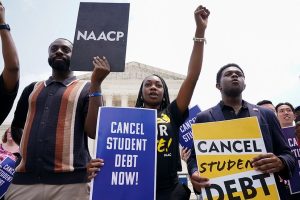The Biden-Harris administration has made a huge step by releasing a detailed proposal that will help millions of Americans who are struggling with student loan debt. With student loan debt being a major problem in the US, the administration’s most recent effort offers significant financial relief to debtors all throughout the country. This article explores the specifics of the new proposals, their ramifications, and the larger background of government initiatives to change the student loan program.

The Biden-Harris Administration’s Student Debt Relief Strategy
President Biden has made education reform a top priority since taking office. He has focused especially on reducing the enormous debt that tens of millions of Americans have from student loans. Through a series of legislative and executive steps, the administration’s strategy has changed with the goal of giving debtors immediate relief and changing the student loan system in order to prevent future debt crises.
Historical Context and Progress
Four million Americans have had their school debt forgiven to the tune of about $146 billion under the Biden-Harris administration. More than two dozen executive measures have been taken as a result of these acts, including modifications to the Income-Driven Repayment (IDR) and Public Service Loan Forgiveness (PSLF) programs. These changes have resolved long-standing problems with the management of federal student loans and made it simpler for borrowers to obtain the relief to which they are legally entitled.
The SAVE Plan: A Paradigm Shift in Student Loan Repayment
A cornerstone of recent reforms is the SAVE (Simplified Affordable Valued Education) Plan, which significantly reduces the financial burden on borrowers by:
- Halving payments for undergraduate loans.
- Preventing unpaid interest from increasing total loan balances.
- Setting many borrowers’ monthly payments to $0.
- Accelerating debt cancellation for borrowers with lower balances.
Details of the New Debt Cancellation Plans Announced
President Biden’s latest announcement introduces several key initiatives designed to extend and expand debt relief for millions more Americans. These include:
Canceling Accrued Interest
- Impact: Targets over 25 million borrowers who owe more on their student loans than they initially borrowed.
- Details: Up to $20,000 of accrued interest cancellation for borrowers, depending on their income and repayment plan, particularly benefiting those in the SAVE or other IDR plans.
Automatic Debt Cancellation
- Eligibility: Borrowers eligible under the SAVE Plan, PSLF, or other specific discharge programs who have not applied for these benefits.
- Goal: Simplify the process and eliminate bureaucratic hurdles to make debt relief more accessible.
Focused Relief for Long-term Borrowers - Scope: Aims to cancel loans for borrowers who entered repayment 20 or more years ago, with additional provisions for those with graduate student debt.
Addressing Educational Value
- Objective: Crack down on institutions that have burdened students with debt without delivering adequate job prospects or educational outcomes.
- Method: Cancel debt associated with programs that have lost eligibility for federal student aid due to regulatory non-compliance or poor outcomes.
Economic and Social Implications
The administration contends that student loan cancellation will have both broader economic advantages and individual financial relief. These include higher rates of property ownership, higher levels of consumer expenditure, and higher credit scores among the recipients. Furthermore, the action is viewed as a critical step toward educational justice, with the ability to reduce the income gap and give more Americans the chance to seek higher education without being discouraged by the prospect of debt in the future.
Potential Challenges and Criticisms
Opposition to the ideas has been faced despite their apparent benefits. Opponents contend that the benefits of debt cancellation are unjustly distributed, favoring those with better incomes or those who opted for more expensive educational pathways, and that the expense of debt cancellation could be onerous for taxpayers. There could also be political and legal opposition, especially from individuals who think that Congress should be consulted before enacting such a large-scale change rather than the executive branch.

The ideas for student debt forgiveness announced by the Biden-Harris administration are a daring solution to a recurring issue that millions of Americans face. In order to lessen the financial burden of student loans and promote more economic stability, the administration intends to simplify the application procedures, increase the eligibility for debt relief, and focus on particular borrower categories. These proposals, which represent the intricate relationship between economic health and education policy, will surely come under intense public and political scrutiny when they are implemented.
Frequently Asked Questions (FAQs)
Who qualifies for the new student debt cancellation plans?
Borrowers with federal student loans who meet specific criteria related to their income, repayment history, and the type of education program attended.
How much debt relief can eligible borrowers expect?
Relief ranges from partial to full loan forgiveness, with some borrowers eligible for up to $20,000 in cancelled accrued interest.
What steps must borrowers take to apply for debt cancellation?
Some aspects of the new plans require no application if the borrower is already enrolled in eligible repayment plans or programs. Others might require updated documentation to verify eligibility.
Are there any plans to address the underlying issues causing high student debt?
Yes, beyond cancelling existing debt, the Administration is implementing regulatory reforms to prevent exploitative educational practices and to enhance the overall value of higher education.
What is the timeline for the implementation of these debt relief measures?
The Administration plans to roll out these initiatives in phases, with some measures set to begin in the coming months and others pending further negotiation and rule-making processes.
This comprehensive approach aims to not only alleviate the immediate burden of student loans but also to reform the system to ensure higher education serves as a gateway to economic opportunity rather than a financial barrier.
Read Also – Australia Family Tax Benefit 2024: How To Claim And Rates Calculation



